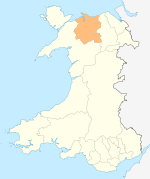- Deganwy
-
Deganwy (Middle Welsh Degannwy, Brythonic *Decantouion) is a village in Conwy County Borough in Wales with a population of 3,700. It is in a more English-speaking region of North Wales, with only 1 in 4 residents speaking Welsh as a first language. It is located south of Llandudno and to the east of Conwy, which is on the opposite side of the River Conwy, and with which it forms the Conwy community. Indeed, the name Deganwy has been interpreted in modern times as Din-Gonwy, which would mean "Fort on the River Conwy", but the historical spellings make it impossible for this to be the actual origin of the name. Deganwy is in the ecclesiastical parish of Llanrhos, and has a Victorian era Gothic parish church dedicated to All Saints.
Contents
Education
Deganwy has one bilingual primary school, Ysgol Deganwy.
Deganwy Castle
Deganwy's most notable feature is Deganwy Castle,[1] situated 110 m above the town, which, in the 6th century was fortified as the stronghold of Maelgwn Gwynedd,[2] king of Gwynedd. Deganwy appears to have been the capital of Gwynedd at this time, but this was later moved to Aberffraw on Anglesey. The hill on which the castle was built was fortified many times over the centuries. It was the site of a Norman castle built around 1082 and occupied by Robert of Rhuddlan, and later by Llywelyn the Great and Llywelyn ap Gruffudd. The castle was later demolished by Edward I when Conwy Castle was built opposite so that only ruins remain today.
Rail and sea
Deganwy has a railway station on the Llandudno branch line with an hourly train service, available on request, to and from Manchester Piccadilly and intermediate stations. The LNWR built at Deganwy a rail connected riverside quay and wharfs, largely for the purpose of exporting slate by coastal steamer. The slate was brought by rail from Blaenau Ffestiniog. A marina with its accompanying housing and hotel accommodation was established on the site of the former slate wharfs early in the 21st century.
External links
- Deganwy Castle
- Deganwy Quay - official site
- Deganwy Quay - photographic tour
- www.geograph.co.uk : photos of Deganwy and surrounding area
Footnotes
See also
Coordinates: 53°18′N 3°50′W / 53.3°N 3.833°W
Conwy County Borough Principal settlements Abergele • Colwyn Bay • Conwy • Llandudno • Llandudno Junction • Llanfairfechan • Llanrwst • Old Colwyn • Penmaenmawr • Penrhyn Bay
Towns and villages Bettws-y-Coed • Caerhun • Capel Curig • Capel Garmon • Cerrig-y-drudion • Deganwy • Dinmael • Dolgarrog • Dolwyddelan • Eglwysbach • Glan Conwy • Henryd • Kinmel Bay • Llanbedr-y-Cennin • Llanddoged • Llanddulas • Llanfair Talhaiarn • Llangernyw • Llanrhychwyn • Llysfaen • Maenan • Mochdre • Pandy Tudur • Penmachno • Rhos-on-Sea • Rowen • Tal-y-bont • Tal-y-Cafn • Trefriw • Towyn • Ysbyty IfanRivers Castles and forts Canovium • Conwy Castle • Deganwy Castle • Dolwyddelan Castle • Gwrych Castle • Gwydir Castle • Pen y GaerCategories:- Towns in Conwy county borough
- Clwyd geography stubs
Wikimedia Foundation. 2010.



